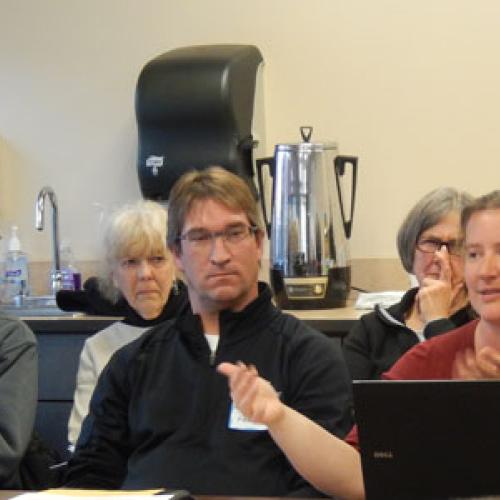A gaggle of northeast Minnesotans filled a room on the University of Minnesota Duluth campus on December 1, 2014 to learn about the City of Duluth’s clean energy updates. The event was hosted by Northeast Clean Energy Resource Team (NE CERT). Read on for links and summaries of presentations!
City of Duluth MN GreenStep Cities
DyAnn Andybur, City of Duluth Energy Coordinator
Duluth signed on to the Minnesota GreenStep Cities program in Spring 2014. GreenStep Cities is a voluntary best practice program that now has 75 cities participating across the State. Read more about the program here: http://greenstep.pca.state.mn.us/
Duluth has been working on variety of best practices which DyAnn highlighted in her presentation. A few highlights include a whole heap of energy related best practices including cutting energy usage in lighting and signals, testing solar wall technology, participating with Class5 Energy for a plug loan and city energy use behavior change program, and light modeling to be able to cut the number of fixtures needed while still ensuring safety and the lighting needed.
Duluth Energy Futures Project
Jodi Slick, Ecolibrium3
Jodi kicked off her discussion of the Duluth Energy Futures Project by talking about Duluth’s Sister City in Sweden – Vaxjo (pronounced “Vequa”) – which went through a similar planning process in 1979 and has since transformed their energy mix while growing their economy. She then went on to describe the many components at work in Duluth driving an energy transformation – including Minnesota Power’s plans to remake their energy mix, Western Lake Superior Sanitary District’s plan to do more biogas recovery, and the Duluth District Heating system plans. The effort is aimed at looking at an integrated energy plan.
Jodi indicated they are considering a number of questions, including:
- What could we accomplish if we were all pull in the same direction?
- How do we ensure alignment of these efforts with transition of district heating system?
- What’s the business case for making the energy transition?
- What are the economics of no change and what do they look like under other scenarios? What about the environmental impacts under those various approach?
- What’s the pathway to make an energy transition happen?
City of Duluth Steam Plant
Jim Green, Evergreen Energy
Jim described that Duluth’s Steam Plant is the most carbon emitting feature in Duluth… which presents a big opportunity. The system was originally built in 1932 and the only thing that has changed since then is the addition of some emissions equipment.
So, what are those opportunities? For starters, the Plant pulls 90 million gallons of water from lake and then essentially recycles it back to the lake after it turns to steam. This is a pretty energy intensive process as it has to heat up cool Lake Superior water to the temperature of steam. Second, steam has a few perils and pitfalls – including things like: it likes to escape from pipes. He described a flyover analysis they did to identify “hot” areas where the system is leaking. In Canal Park they have a hot water system and you don’t see any leaks, but in places where they use steam… they do. It’s both energy inefficient and there are losses in the system. These factors = opportunity!
They now have a master plan to convert the whole system to a hot water system where they reuse the water in the system over and over again (rather than drawing it from the Lake). This sort of conversion would also mean they could think about other systems – like solar thermal – to inject additional heat into the system. At this point, they are planning a hybrid system until they can convert the whole thing – which will involve digging up city streets and laying new pipes as well as adding new handling equipment for end users.
Click here to see the whole plan >>
More updates from Jodi
Georgetown University Prize: Jodi announced that the City of Duluth has made it to the quarter finals (one of 50 communities who have) for the Georgetown University Prize. The Georgetown University Prize is a monetary prize that aims to incentivize innovation. The prize money is $5,000,000 (!) and it’s targeted to cities with a population of 5,000-250,000. The challenge: over the course of 2 years, which community could reduce electric and gas use in residential and municipal sectors. The primary metric is total energy use of residents and the municipality divided by the total number of utility accounts – all to be weather normalized. They want creative partnerships and making the quarter finals means they have the right partners at the table including the City, community partners and utility. The two year clock runs from January 1, 2015 to December 31, 2016. Go Duluth!
Western Lake Superior Sanitary District (WLSSD): Mary Ann Bourne of WLSSD described their new four-phase energy self-sufficiency project. It includes a proposal for four 1 million gallon digesters to digest their solid and generate biogas. They would then use that to heat their buildings. Their digesters have additional capacity and could double the amount of biogas they are producing right now which would allow them to generate electricity to cover 50-80% of their electric needs. 2015 will kick off the first phase of their project. In 2016 they aim to add 9 modular units and in 2017-2018 to install energy generators. They are working with NRRI to identify additional feedstocks. The fourth stage would be to look at scrubbing and compressing gas for use in natural gas vehicles.
See photos from this event
About the Local Government Energy Action Series:
This effort tells the stories of Minnesota municipalities, counties, and schools and the tangible results of their energy-saving efforts to inspire others to take their own actions.


